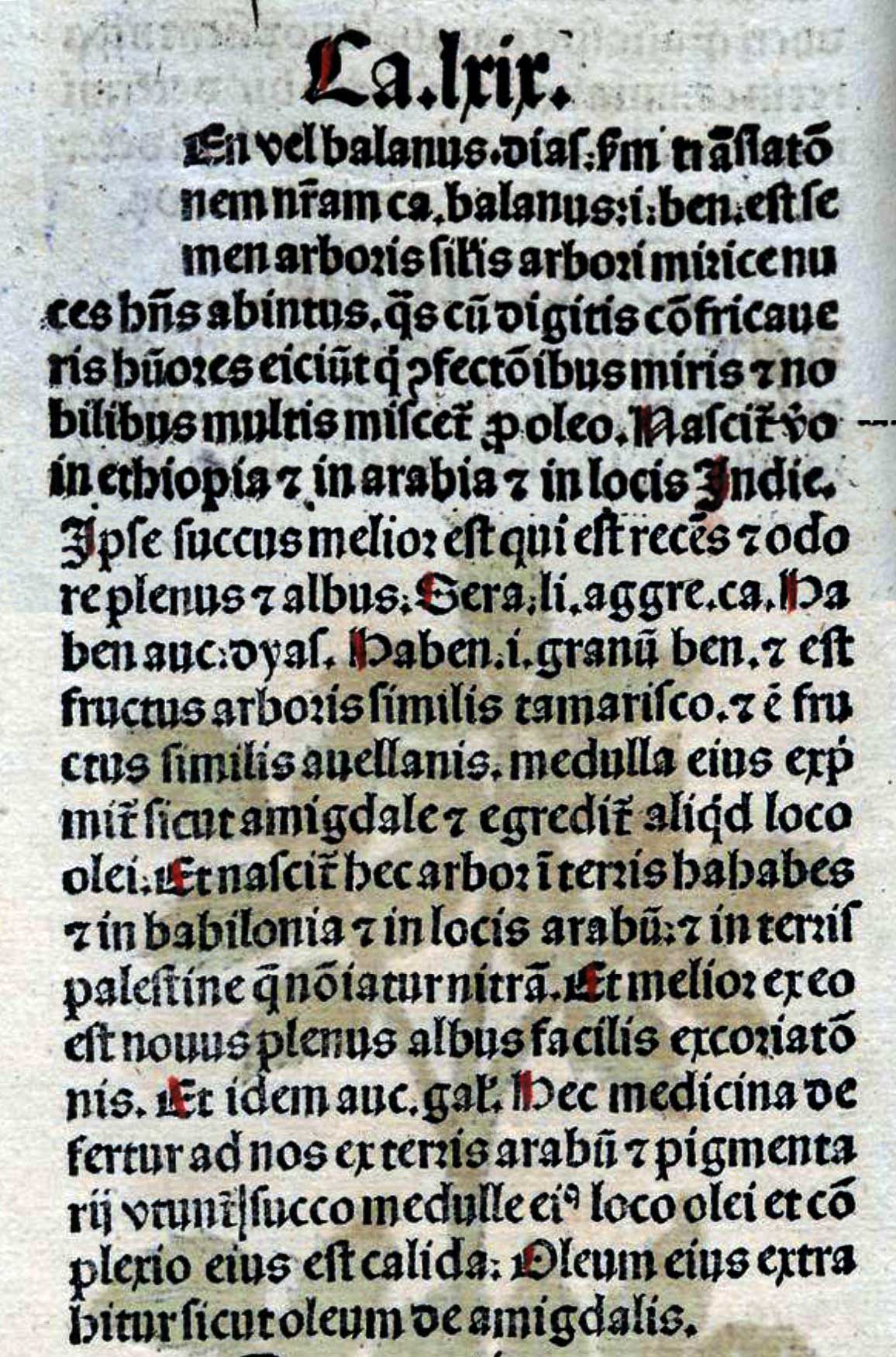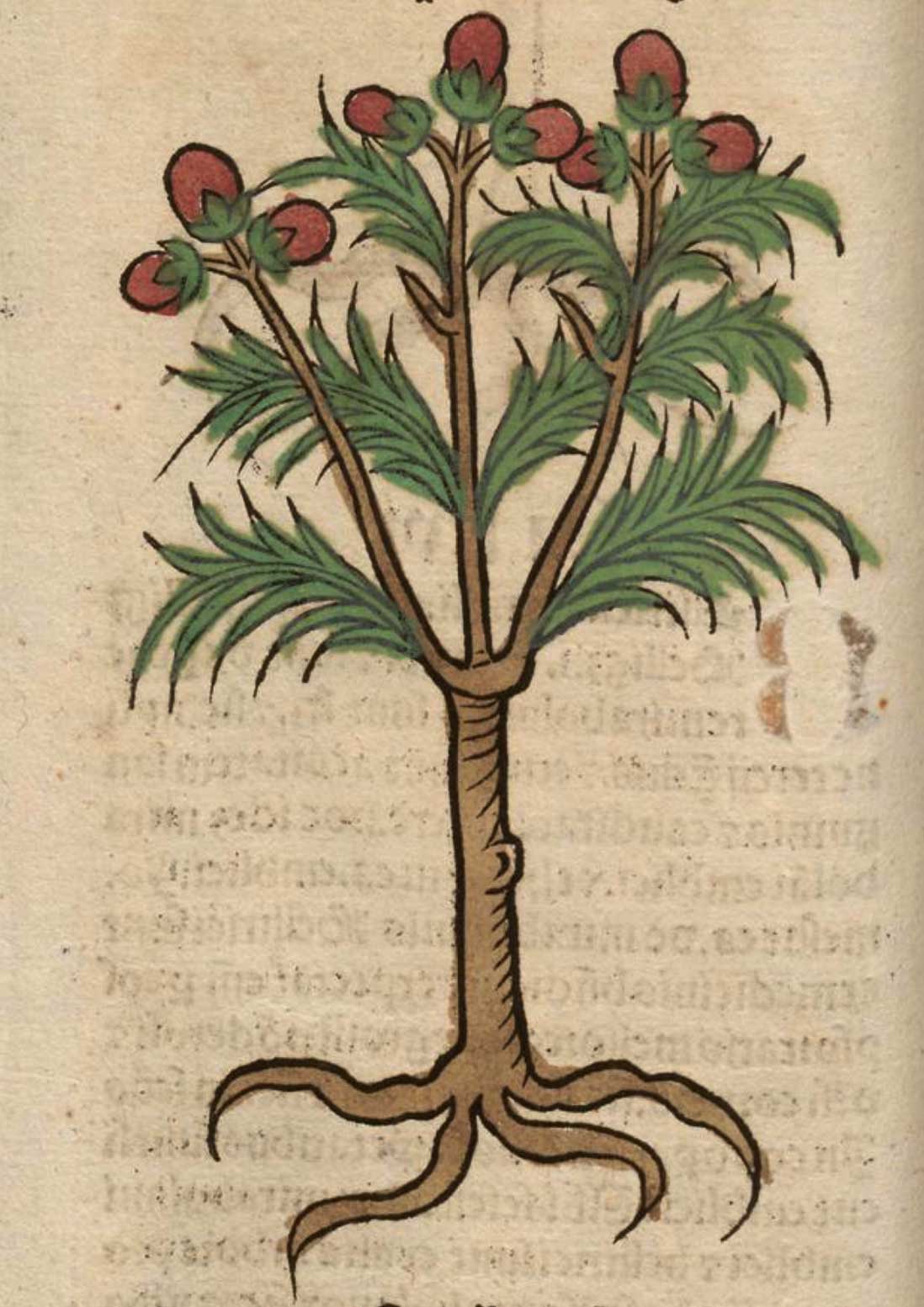If Oxylus son of Orius had begotten it on his sister Hamadryas,
Original French: Si Oxylus filz de Orius l’euſt de ſa ſoeur Hamadryas engendrée,
Modern French: Si Oxylus filz de Orius l’eust de sa soeur Hamadryas engendrée,
Notes
Balanus (text)
Balanus
Oxylus
In his discussion of the names of figs (sukai) in Book II of Inquiry into Plants, Tryphon (fr. 119 Velsen) says that Androtion in his On Agriculture (FGrH 324 F *76) records that when Syceas, who was one of the Titans, was being pursued by Zeus, his mother Earth protected him and made the plant grow up to entertain her child, who also gave his name to the city of Sycea in Cilicia. But the epic poet Pherenicus (SH 672), who was a Heracleot by birth, claims that the name came from Sycē (“Fig Tree”) the daughter of Oxylus. For Oxylus son of Oreius had sex with his sister Hamadryas and begot, among others, daughters named Nut-tree, Oak, Cornel-cherry, Mulberry, Poplar, Elm, Grapevine, and Fig-tree. They were referred to as the Hamadryad [Literally “Simultaneous with a Tree,” the point of the name being that the nymph lived as long as the tree with which she was associated] nymphs, and many trees got their names from them. Hipponax (fr. 52 Degani) as well, therefore, says:
a dark fig tree, sister of a grapevine.
Oxylus
Voiez Athénée, l. 3 chap. 3.
Oxylus
Oxylus, &c.] See Athenaeus l. iii, c. iii
Oxylus
Voiez Athénée, l. 3 chap. 3. (L.)
Oxylus
Voy. Athénée, l. III, c. III.
Oxylus
Légend tirée d’Athénée (Banquet, 3, 78). Oxylus, fils d’Orius, eut de sa sœur Hamadryas huit filles qui furent les Hamadryades, et présidèrent à divers arbres. Les noms d’arbres sont dès lors féminins dans l’original. Rabelais, sans y prendre garde, en a tradiuit la majeure partie par des noms masculins, et parfois arbitraires: si l’on retrouve Ampelos dans la vigne, Sikê dans le figuier, Carya dans le noyer, Ptelea dans l’ulmeau ou orme (Hœfer y veut voir un peuplier), par contre Balanos n’est peut-être pas le chêne comme le prétent Rabelais, mais quelque arbre glandifère indéterminé (on a pensé au Myrobalan); et il n’est pas davantage prouvé qu’Orea soit la nymphe du hêtre, comme le veulent les Anciens, ou celle du Fenabrégue que Rabelais endend lui dédier. (Cf. A. Garrigues, A propos d’un passage de la botanique de Rabelais, L’association médicale, october, 1923, p. 219-222). (Paul Delaunay)
Hamadryas
C’est la légende des Hamadryades (nymphes des arbres) , raconté par Athénée, Banquet, III, 78; cf. Gyraldi, Syntagma de deis gentium, Bâle, 1555, 170. L’ulmeau (l’orme) « feut grand Chirurgien en son temps », sans doute parce que les Anciens corrigeaient les enfants et les esclaves avec des verges d’orme (d’ou l’adjectif ulmi-tribus).
Oxylus et les hamadryas
D’après Athénée, Banquet des Sophistes, III, 78. Oxylos, fils d’Oréios, épousa sa propre sœur et eut avec elle des nymphes d’arbres ou hamadryades: Carya, Balanos, Crania, Moréa, Aegiros, Ptéléa, Ampélos, Sycé. La fénabrègue, ou fabréguier, est le micocoulier.
hamadryad
hamadryad. Also in Lat. form hamadryades [adaptation of Latin Hamadryas, adopted from Greek Amadruaj, chiefly in pleural, wood-nymphs, formed on ama together with + druj tree]
Greek and Latin Mythology. A wood-nymph fabled to live and die with the tree which she inhabited.
C. 1386 Chaucer Knight’s Tale 2070 In whiche they woneden in reste and pees Nymphus, ffawnes, and Amadrides [v. rr. amadries, Amadryes].
1390 John Gower Confessio amantis II. 336 With suche, as Amadriades Were cleped wodemaidens tho.
1590 Edmund Spenser Faerie Queene i. vi. 18 The wooddy nymphes, faire Hamadryades,… And all the troupe of light-foot Naiades.
1664 John Evelyn Sylva, or a discourse of forest-trees §13 (R.) The fittest sacrifice for the royal oaks, and their hamadryads.
Oxylos
OXYLOS (Oxylus) was the rustic demi-god (daimon) of mountain forests (or perhaps more specifically the mountain beech). He was a son of Oreios “the Mountain” and husband of Hamadryas “She-with-Tree” and the father of eight Hamadryad-nymph daughters who each presided over a species of tree. His son Andraimon (Andraemon) was an early king of the mountain-dwelling Dryopes tribe. Oxylos was primarily associated with the mountain-forests of central Greece–the Pindus mountain range, Mount Oita (Oeta) and Mount Othrys.
Oxylos’ name is perhaps derived from the term axylos hylê, “virgin mountain-forest”, or it could be connected with oxya, “beech-tree” (Fagus sylvatica). If the latter is the case, then his wife Hamadryas is probably drys, “oak”, rather than drys, “tree” in general.
Oxylos is probably related to Hekateros (Hecaterus) and Seilenos (Silenus)–two rustic demi-gods who were also described as fathers of the Dryades and Satyroi (Satyrs).
PARENTS: OREIOS (Athenaeus 78b)
OFFSPRING: [1.1] THE HAMADRYADES (KARYA, BALANOS, KRANEIA, MOREA, AIGEIROS, PTELEA, AMPELOS, SYKE) (by Hamadryas) (Phereclus Frag, Athenaeus 78b)
[1.2] THE HAMADRYADES, ANDRAIMON (Antoninus Liberalis 32)
CLASSICAL LITERATURE QUOTES
Athenaeus, Deipnosophistae 1. 78b (trans. Gullick) (Greek rhetorician C2nd to C3rd A.D.) :
“The Epic poet Pherenikos (Pherenicus), a Herakleto by birth, declares that the fig (Sykon) was named from Syke (Fig-Tree), the daughter of Oxylos (Beech-Tree); for Oxylos, son of Oreios (Mountain), married his sister Hamadryas (Plum Tree) and begot among others, Karya (Walnut-Tree), Balanos (Oak-Nut Tree), Kraneia (Cornel-Tree), Morea (Mulberry-Bush), Aigeiros (Poplar-Tree), Ptelea (Elm-Tree), Ampelos (Grape-Vine), and Syke (Fig-Tree); and these are called Nymphai Hamadryades (Hamadryad Nymphs), and from them many trees derive their names.”
Antoninus Liberalis, Metamorphoses 32 (trans. Celoria) (Greek mythographer C2nd A.D.) :
“Dryops (Oak-Face) was the son of the River Sperkheios (Spercheus) and of Polydore (Many-Gifts), one of the daughters of Danaos (Danaus). He was king in Oita (Oeta) and he had an only daughter, Dryope (Oak-Face). She herself herded the flocks of her father. Now, the Nymphai Hamadryades (Hamadryad Nymphs) [probably the daughters of Oxylos] were very much attached to her and made her their companion, teaching her to sing to the gods and to dance. Apollon, seeing her dancing, felt an urge to couple with her. He first changed himself into a tortoise. Dryope, with the other Nymphai, was amused by it and they made a toy of the tortoise. She placed it in her bosom. He changed from a tortoise to a serpent.
The frightened Nymphai abandoned Dryope. Apollon coupled with her and she ran full of fear to her father’s house, saying nother to her parents. When Andraimon (Andraemon), son of Oxylos (Oxylus), later married her, she gave birth to Amphissos, the son of Apollon .
He became the king of the places thereabouts. In Dryopis he established a sanctuary of Apollon. One day, as Dryope was approaching the temple, the Nymphai Hamadryades gathered her up affectionately and hid her in the woods. In her place they caused a poplar to appear out of the ground.”

